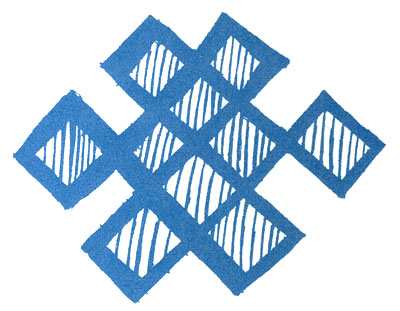
There have been moments in my life when I’ve felt that I found Buddhism mostly so that my daughter, Maud, now fourteen, could grow up around a dharma practitioner. It’s never been a problem, trying to practice with Maud around the house: At five, she was as fascinated by the idea of my sitting as she was by everything else I did. For a five-year-old, how was my practicing shamatha different from my putting on makeup, doing yoga in the middle of the living room floor, driving a stickshift, struggling for hours at my computer over a single paragraph? It was all the same to her—the mystery of Mama, and of womanhood, and of humanness.
The truth is I didn’t have a regular, daily practice then, because I didn’t understand the dharma enough to know why I should. I meditated a few times a week for the relief of the gap in my discursiveness. I meditated to get some space from the frantic and sometimes unhappy life of a single mother. I meditated so that I could calm down enough to give my daughter the attention she needed. Even at five, Maud seemed to understand this. She let me sit, I imagined, because sitting so obviously made me a nicer mom.
Related: The Dismay of Motherhood
Not all kids are like my daughter—I know that. Maud’s acceptance of me as a practitioner, her wish to begin sitting with me when she was ten years old, her insistence that she take refuge when she was eleven, began to crack the resistance I had to basic Buddhist notions about past and future lifetimes, and about karma: Maud, it was slowly becoming clear to me, had been born into this lifetime with more generosity and patience than most people develop after years of practice—enough generosity and patience to allow her mother to find her path at thirty-six, and enough merit to step onto the path herself at age eleven.
When Maud joined me as a Buddhist, I was able to begin to go to more programs and hear more teachings (she came along to these adult events with some reluctance, and usually spent her time there trying to perfect her line drawing of a knot of eternity). I found my root teacher, Sakyong Mipham Rinpoche, at one of these programs, and it was through his traditional teachings that I heard what I knew all along but had been avoiding: that if I wanted to progress along the path—to begin to cut through habitual patterns, loosen the sense I had that I and the rest of my world were solid, have any ability to arouse bodhicitta—I was going to have to make practice my first priority, and Buddhism my life. The four reminders—the truth of precious human birth, impermanence, karma, and the futility of samsara—were going to have to become parts of my blood and bones through contemplative meditation. Not only that: it wasn’t enough for me to be a student of the dharma. I would have to set an example for my daughter by living the teachings in our life together. As far as I can tell, there is only one way to do this, to live a dharmic family life, to be a dharmic mom: daily practice.
Related: Mothering as a Meditation Practice
I started my prostration practice last fall, setting up a ngondro shrine in my bedroom, adjacent to Maud’s. She tells me that she likes the chants I begin with each morning and has memorized them, the way kids memorize songs they hear over and over on the radio. When her friends come by, she sometimes brings them into that shrine space, takes down my slick prostration board from behind the door, lights a stick of incense, and, with her friends, skates, slides, and falls, laughing, at the foot of the lineage tree hanging on the opposite wall. It is at these times that I imagine my root guru and the lineage teachers, all the buddhas and protectors, all the members of the sangha, watching over my daughter as she does naturally what I hope, through my practice, to someday do: play openly and unreservedly in this most ordinary and sacred world.
Thank you for subscribing to Tricycle! As a nonprofit, we depend on readers like you to keep Buddhist teachings and practices widely available.